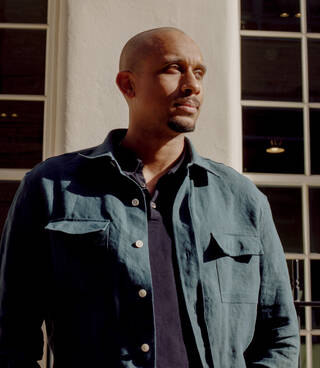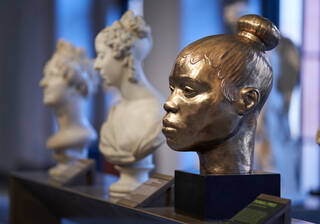I’ve been looking at this [V&A] collection my whole life.

A Londoner, Thomas J Price recalls coming to visit the V&A with his mother as a little boy, and also as a student while at the Royal College of Art. From a young age, he was acutely aware of the absence of people that looked like him among the sculptures on display in the museum. It's a collection that has informed his practice, prompting thoughts about representation and the ways in which art is displayed, particularly within the context of the Sculpture Galleries – a collection that his own work questions and critiques, and in which his work is in dialogue in this display.
Price is one of the leading artists working in Britain today. Although he works across a number of disciplines, he is perhaps best known for his sculpture, particularly his large-scale works of seemingly everyday people. Arresting yet contemplative, they feature anonymous Black men and women. Deceptively realistic in feel, his figures are not portraits, but composites – amalgams of the traits, attitudes and style of individuals he encounters on the streets of London.

Warm Shores, two monumental figures outside Hackney Town Hall in East London, is a permanent public work unveiled in June 2022 which celebrates the Windrush generation and their descendants. Even larger in scale, Moments Contained (2022) stands in the V&A's Exhibition Road Courtyard, within the grand setting of elaborate Victorian facades and contemporary porcelain tiles. Price describes this figure as "a sculpture about statues" for how this 12ft high bronze figure challenges our understanding of public monuments. Bronze, like marble, is a material traditionally associated with the celebration of people of power, people whose actions may ultimately prove controversial, or even dishonorable. Here, Price responds to a long history of glorifying individuals and ideologies through sculpture with a fictional young woman in casual sportswear, lost in her thoughts and in the moment. Her poise and attitude are easily relatable, bringing attention to the shared moments we experience and what connects us as a society.
With a focus on creating empathy and encouraging conversation, Price's work interrogates how we look at sculpture in the public realm – whether in the street or in the museum.

Placed amongst some of the most iconic works in our sculpture galleries, three monumental heads on marble plinths gaze across the space. These pieces, entitled Numen (Shifting Votive One, Two and Three) (2016), reference Egyptian, Greek and Roman antiquity (in Latin, 'numen' means 'divinity' or 'divine presence'), but placed at eye level, face-to-face with the viewer, they subvert the traditional notion of worship. Made of aluminium – a commonly used, relatively cheap material – they have a distinctly contemporary feel. The exquisite detail and surface texture creates a tactile quality that reveals veins, facial and head hair and even pores.

In raw bronze, polished to look like gold, and surrounded by pale marble busts of fashionable 18th- and 19th-century women, Lay It Down (On the Edge of Beauty) (2018) makes a strong statement. Her beautiful facial features are framed by the styled 'baby hairs' on her forehead and she wears her hair in a contemporary bun. While drawing our attention to hairstyling as an important feature of Black female identity and self-expression, Price also highlights the appropriation of this style by the fashion world and it being deemed fashionable only when recreated on a white model on a magazine front cover, effectively pushing Black female styling to being 'on the edge of beauty'.

Also made of polished bronze, Signals (2021) shows a man holding his mobile phone in the air, trying to find a signal. The sculpture engages with isolation and connectedness in a society where we so heavily rely on technology for our interactions. Its gesture and position on a pedestal also recalls that of heroic statuary, as in Vincenzo Foggini's 18th-century Samson and the Philistine, displayed alongside. But where Foggini's sculpture is one of aestheticised, brutal violence, the mundane nature of this contemporary figure poignantly references the misrepresentation of Black masculinity in the media.
I want people to recognise themselves and feel valued.

Price's work probes questions of representation, perception and power, prompting us to think about the nature of monuments: who is represented and why? His sculptures occupy space, but, just as importantly, they 'make' space – space for discussion, for inclusion, and for what he calls "experiences in radical empathy". Combining a love for material with an acute observation of the language of sculpture, Price challenges established, exclusionary, social constructs to create a greater sense of connection and shared experience.
